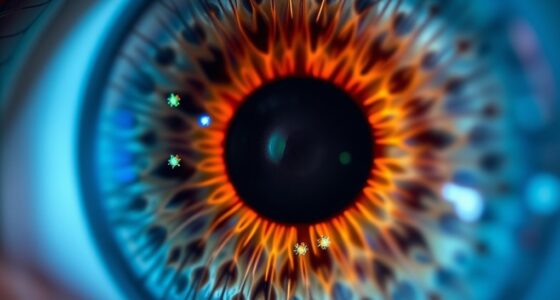Nanoparticle contrast agents for ultrasound and photoacoustic imaging come in types like gold, iron oxide, and silica, chosen for their excellent imaging properties. They work by increasing signal strength through mechanisms such as clustering and improved light absorption, making tumors and tissues more visible. These agents enable precise diagnostics and targeted treatments. However, challenges like stability, targeting, and safety remain. Exploring further reveals how ongoing advances aim to improve their effectiveness and safety in medical settings.
Key Takeaways
- Nanoparticle contrast agents, such as gold and iron oxide, enhance ultrasound and photoacoustic imaging by increasing echogenicity and optical absorption.
- Surface modifications improve nanoparticle stability, biocompatibility, and targeting capabilities for precise imaging of tissues and tumors.
- Clustering or aggregation of nanoparticles amplifies signal strength through enhanced impedance differences and thermoelastic effects.
- Challenges include ensuring safety, reproducibility, and effective targeting, with ongoing research focused on surface engineering and scalable manufacturing.
- Regulatory considerations demand thorough biocompatibility testing, long-term safety evaluation, and early engagement with authorities for clinical translation.
Types and Properties of Nanoparticle Contrast Agents
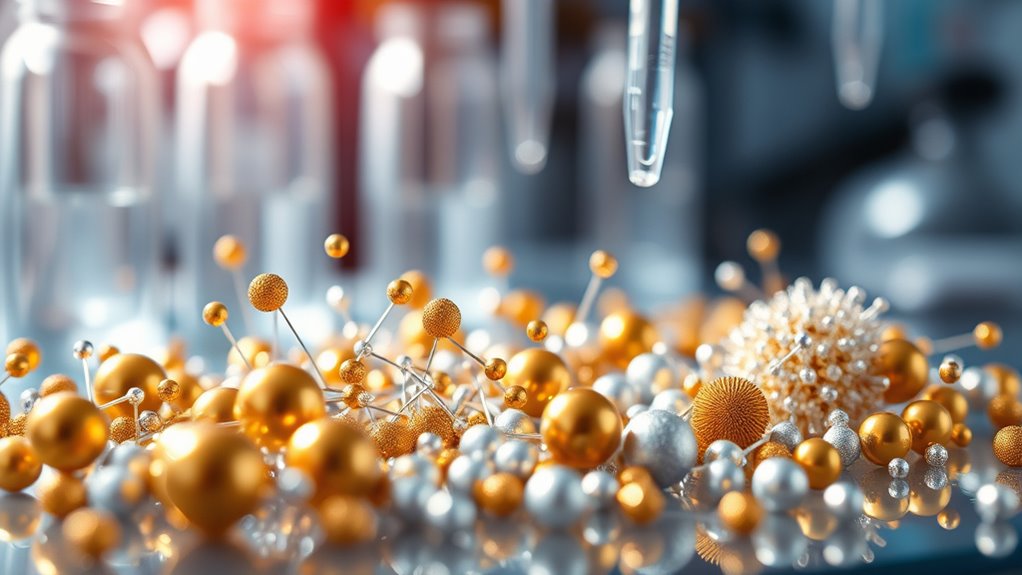
Nanoparticle contrast agents come in various types, each designed to enhance imaging techniques like MRI, CT, or ultrasound. During nanoparticle synthesis, you control their size, shape, and composition, which influence their imaging properties. Surface modification plays a pivotal role in tailoring these particles for specific applications, improving stability, biocompatibility, and targeting ability. By attaching ligands or polymers, you can direct nanoparticles to particular tissues or cells, increasing contrast and reducing side effects. Different materials, such as gold, iron oxide, or silica, are selected based on their imaging capabilities. Optimizing surface chemistry and particle design allows you to enhance their biomedical efficacy, which is critical for successful imaging. This combination of controlled synthesis and surface modification allows you to customize nanoparticle contrast agents for peak performance across various imaging modalities.
Mechanisms of Ultrasound and Photoacoustic Signal Enhancement
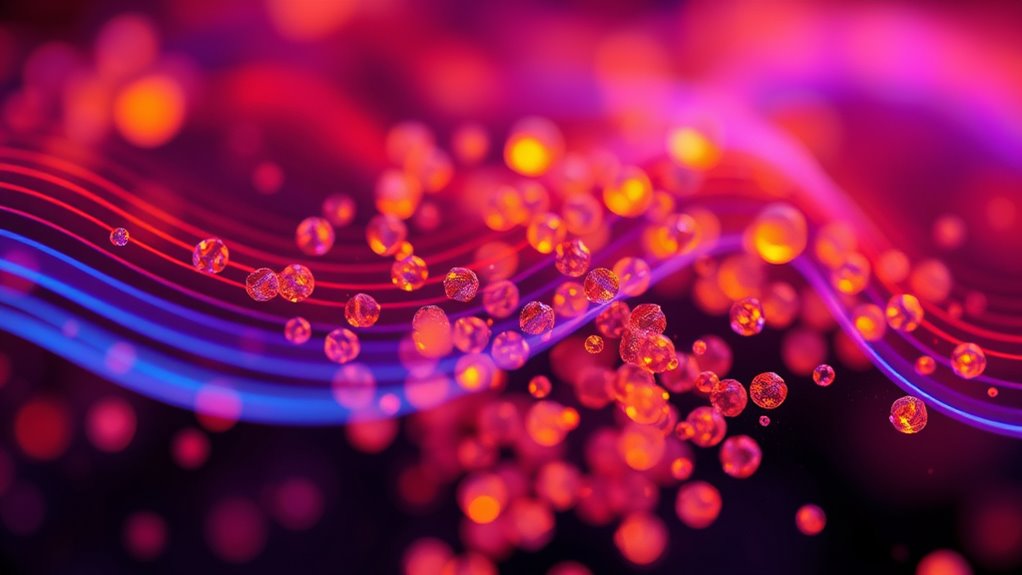
Understanding how contrast agents enhance ultrasound and photoacoustic signals requires examining their interactions with acoustic and optical waves. Nanoparticles improve signals mainly through nanoparticle aggregation, which increases local acoustic impedance differences. This aggregation creates more pronounced reflections of ultrasound waves, boosting echogenicity. For photoacoustic signals, nanoparticle clustering enhances optical absorption, generating stronger thermoelastic expansion and acoustic waves. The variation in acoustic impedance between nanoparticle clusters and surrounding tissues amplifies the generated signals. Additionally, differences in optical properties enhance light absorption, further strengthening photoacoustic output. These mechanisms rely on changes in acoustic impedance and aggregation behavior, which optimize the conversion of acoustic and optical energy into detectable signals. Moreover, the choice of nanoparticle material influences the efficiency of these processes, further impacting imaging quality. Understanding these processes helps tailor nanoparticle design for improved imaging sensitivity and contrast enhancement.
Applications in Medical Imaging and Diagnostics
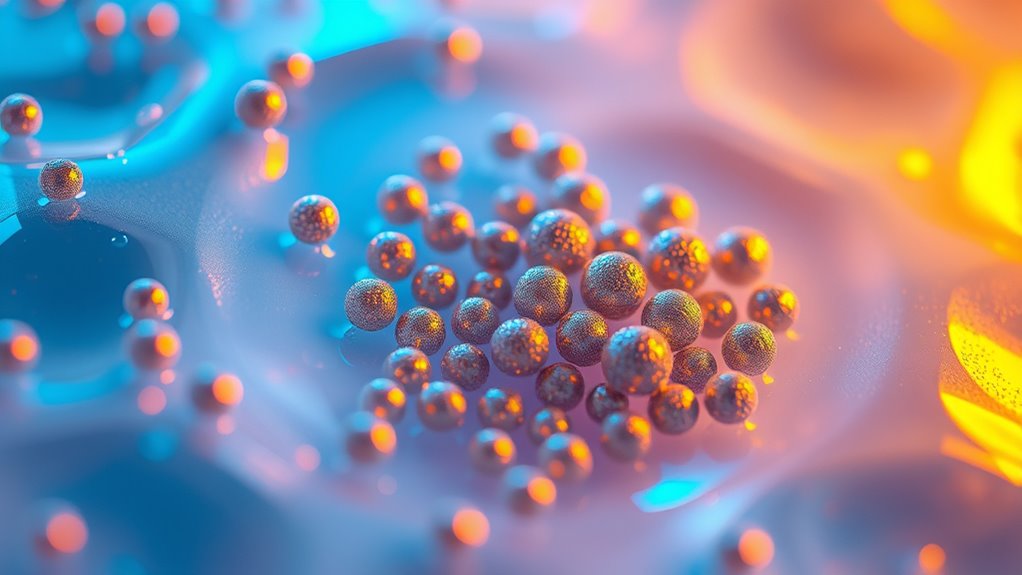
The enhanced signal capabilities provided by nanoparticle contrast agents open up a wide range of applications in medical imaging and diagnostics. You can use these agents for precise tumor detection, monitoring treatment response, and mapping the tumor microenvironment. Their ability to target specific tissues allows for targeted drug delivery, reducing side effects and improving efficacy. In diagnostics, nanoparticles help visualize tumor boundaries better and identify metastases early. They also enable real-time tracking of therapeutic agents within the body, enhancing personalized medicine. Additionally, these agents improve contrast in ultrasound and photoacoustic imaging, allowing for clearer, more detailed images. This combination of targeted imaging and drug delivery facilitates early diagnosis, accurate staging, and optimized treatment planning, ultimately improving patient outcomes. Research indicates that anti-aging effects can be observed when nanoparticle contrast agents are used in conjunction with certain imaging modalities.
Challenges and Future Directions in Nanoparticle Contrast Development

Despite the promising potential of nanoparticle contrast agents, several challenges hinder their widespread clinical adoption. One major obstacle is optimizing surface modification techniques to improve stability, biocompatibility, and circulation time without compromising functionality. Achieving precise targeting strategies remains complex; nanoparticles must selectively bind to specific tissues or cells while avoiding off-target effects. Variability in surface chemistry can affect biodistribution and clearance, complicating standardization. Additionally, manufacturing processes need to be scalable and reproducible for clinical use. Researchers must also address issues related to immune recognition and potential toxicity. Future directions focus on refining surface modification methods and developing smarter targeting strategies that enhance specificity and safety, ultimately paving the way for more effective, personalized imaging agents in clinical settings. Advances in surface engineering continue to play a critical role in overcoming these hurdles and advancing nanoparticle contrast agent development.
Safety, Biocompatibility, and Regulatory Considerations
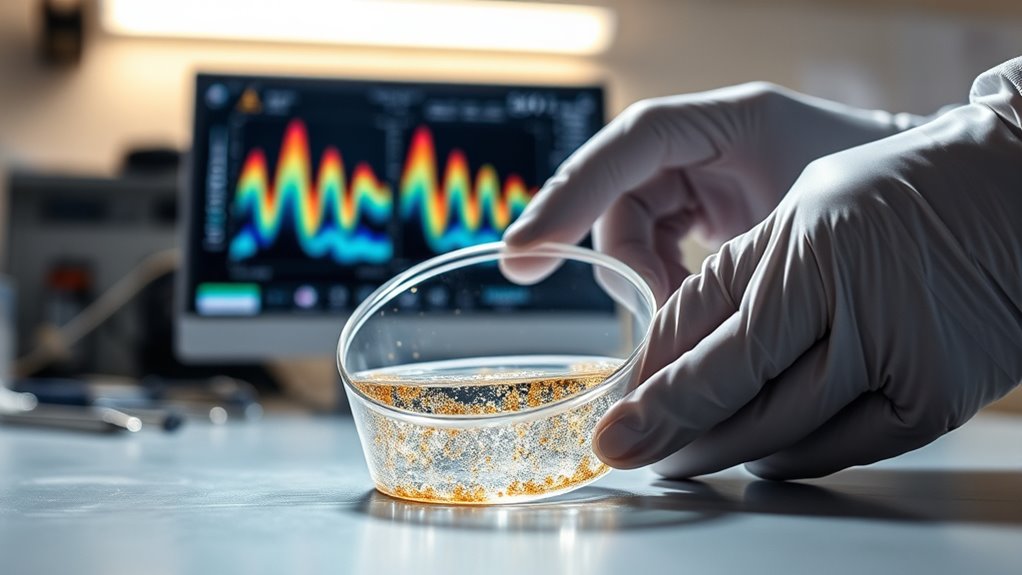
Ensuring safety and biocompatibility is essential for the successful clinical translation of nanoparticle contrast agents. You must perform thorough biocompatibility assessment to evaluate toxicity, immune response, and clearance pathways. Regulatory approval processes require comprehensive data demonstrating safety, stability, and efficacy. Understanding potential long-term effects and interactions helps minimize risks during use. Compliance with standards set by agencies like the FDA or EMA is crucial for approval. You should also consider manufacturing consistency and quality control to meet regulatory requirements. Engaging early with regulators can streamline approval pathways. Key points include:
- Conducting detailed biocompatibility assessments
- Ensuring manufacturing quality and reproducibility
- Demonstrating safety in preclinical studies
- Steering regulatory approval processes
- Addressing long-term safety and clearance
- Recognizing the importance of cybersecurity vulnerabilities in protecting sensitive clinical data during the development and deployment of nanoparticle contrast agents.
Frequently Asked Questions
How Do Nanoparticle Size and Shape Influence Imaging Performance?
You should know that nanoparticle size and shape substantially influence imaging performance. Size optimization ensures better tissue penetration and contrast, while shape engineering enhances targeting ability and signal strength. Smaller particles often provide clearer images, but larger ones can carry more contrast agents. Similarly, rod-shaped or disk-shaped nanoparticles may improve specificity and resolution. By carefully controlling size and shape, you can maximize contrast and achieve more precise, high-quality imaging results.
What Are the Best Methods for Targeting Nanoparticles to Specific Tissues?
Ever wondered how to make nanoparticles find their specific targets? You do this by surface functionalization, attaching ligands that recognize and bind to target tissues. Ligand conjugation ensures precise delivery, improving imaging clarity. You can optimize targeting by choosing appropriate ligands and conjugation methods, like covalent bonding or click chemistry. This strategy enhances contrast agent specificity, giving you sharper, more accurate imaging results for your diagnostic needs.
Can Nanoparticle Contrast Agents Be Used for Multimodal Imaging?
Yes, nanoparticle contrast agents can be used for multimodal imaging, enabling combined imaging techniques like ultrasound and photoacoustic imaging. By integrating different contrast mechanisms, you achieve better spatial resolution and functional information in a single platform. This multifaceted integration enhances diagnostic accuracy and allows you to visualize tissues and biological processes more thoroughly, making nanoparticle contrast agents versatile tools for advanced medical imaging.
How Do Environmental Factors Affect Nanoparticle Stability in Vivo?
Environmental factors play a vital role in nanoparticle stability in vivo, with studies showing that over 50% of nanoparticles can degrade or aggregate within hours of administration. You should consider biocompatibility concerns, as pH, temperature, and enzymatic activity influence their stability. These factors can trigger immune responses, reducing effectiveness and causing potential toxicity. To guarantee safe and effective imaging, optimize nanoparticle design to withstand these in vivo environmental challenges.
What Are Emerging Trends in Nanoparticle Design for Enhanced Imaging?
You should focus on emerging trends like enhancing biocompatibility and using biodegradable materials in nanoparticle design. These advancements help create safer, more effective imaging agents that reduce toxicity and improve clearance from the body. Researchers are also exploring surface modifications and multifunctional nanoparticles to boost targeting and imaging precision. By prioritizing biocompatibility improvements and biodegradable options, you can develop contrast agents that are both efficient and environmentally friendly.
Conclusion
As you explore nanoparticle contrast agents, remember they’re the keys revealing clearer visions inside the body’s labyrinth. Like tiny lanterns illuminating hidden pathways, they enhance ultrasound and photoacoustic signals, guiding diagnostics with precision. While challenges remain, your innovations are paving a luminous future. Embrace this journey, for each breakthrough you forge adds a brushstroke to the masterpiece of medical imaging—transforming shadows into clarity and uncertainty into understanding.





